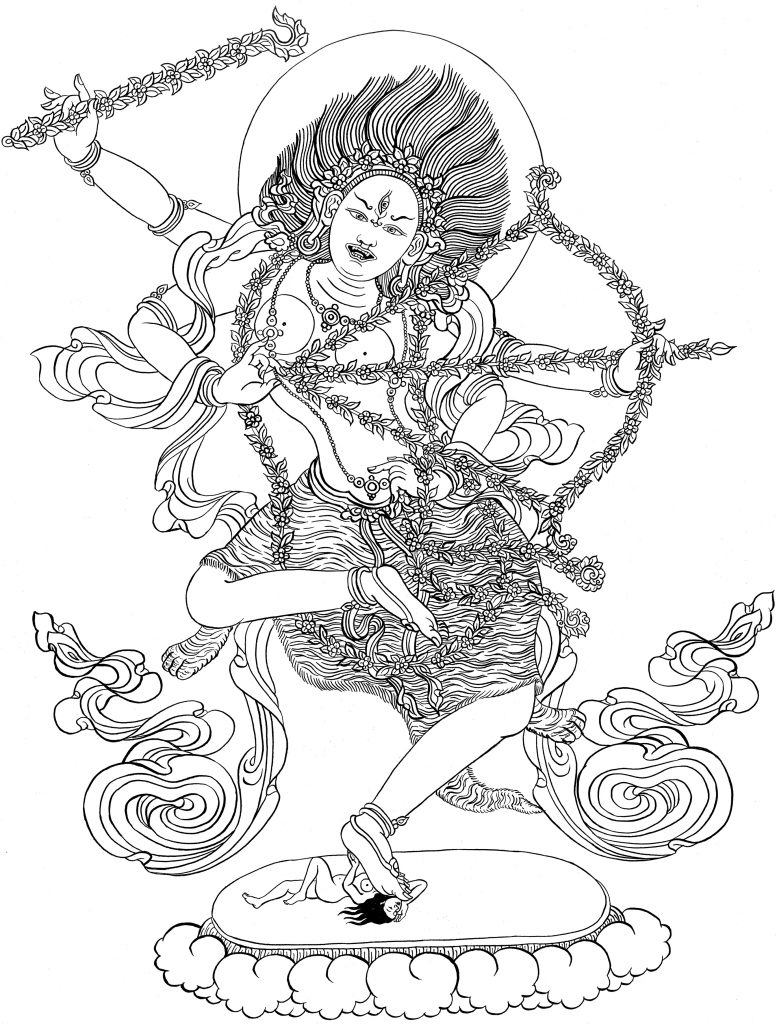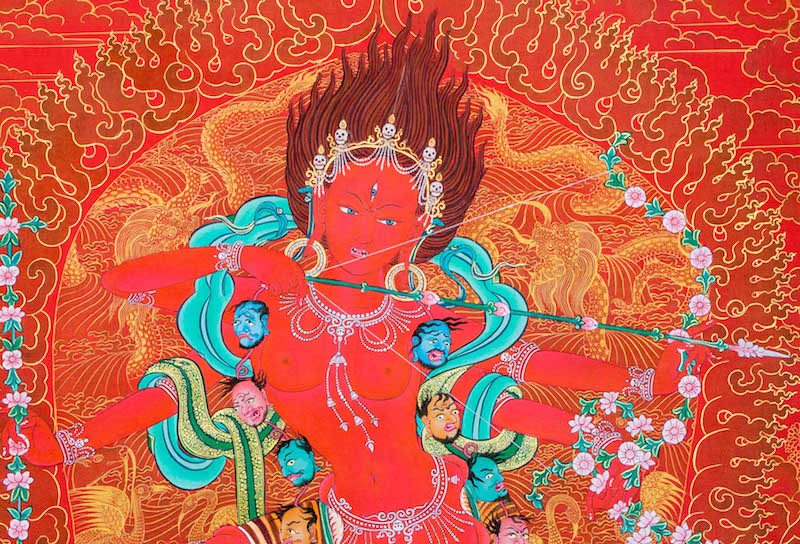In Vajrayana Buddhism, Kurukulla is a goddess of enchantment, magnetism, and love. In the Tibetan language, she is known as Rigjema, or the Mistress of knowledge.
Kurukulla is a dakini, an embodiment of the ultimate wisdom that removes ignorance and turns negative emotions into pure awareness. She is related to the four enlightened activities (Tib. le shi) of pacifying, enriching, magnetizing, and subjugating presented in the Buddhist tantras. She is particularly closely associated with the magnetizing and attraction of favorable conditions (wang gi thrin le).
She also possesses the ability to subdue and transform sensual passions into a tool to reach the higher reality of Dharma. In Vajrayana, it is believed that her enlightened mind is full of passion (chag thug) and impassioned loving kindness (tse we je chag). But in her case, these heartfelt emotions are considered to be devoid of selfish purposes and dedicated entirely to the weal of sentient beings. She offers her unconditional love and tenderness only to eliminate their suffering.
The iconographic images of Kurukulla feature the marks of the Mahayana and Vajrayana female celestials. Her traditional form is described in a prayer from the Namcho Cycle, revealed in the 17th century by Terton Migyur Dorje (1645-67):
With the ruby color of impassioned loving-kindness,
Her lovely enlightened form has one face, four arms, and three eyes.
She gracefully holds a bow and an arrow of flowers, and a magnetizing hook.
To Kurukulle, the victorious one, I prostrate and give praise.
 Her red color symbolizes her passion and her relationship to love. In this role she is associated with the goddess of love, like the Greek Aphrodite and the Roman Venus. The most emblematic element of her iconography, the bow and arrow, reminds one of the Greek Eros or Roman Cupid. These attributes appear almost in all forms of Kurukulla and facilitate both the ritual subjugation of a particular object and for the transformation of consciousness. On the one hand, the bow and arrow are used to attract the desired object, piercing its heart and fill it with love and passion. On the other hand, at a more subtle level these attributes symbolize the transformation of passion into wisdom, as well as the victory over selfish desires and dualistic thoughts.
Her red color symbolizes her passion and her relationship to love. In this role she is associated with the goddess of love, like the Greek Aphrodite and the Roman Venus. The most emblematic element of her iconography, the bow and arrow, reminds one of the Greek Eros or Roman Cupid. These attributes appear almost in all forms of Kurukulla and facilitate both the ritual subjugation of a particular object and for the transformation of consciousness. On the one hand, the bow and arrow are used to attract the desired object, piercing its heart and fill it with love and passion. On the other hand, at a more subtle level these attributes symbolize the transformation of passion into wisdom, as well as the victory over selfish desires and dualistic thoughts.
The distinctive characteristic of Kurukulla is that she is not associated with a male partner, nor depicted with a trident that symbolizes this relationship. This means that, as an embodiment of universal and unconditional love, she does not need a particular partner but is committed to love among sentient beings in a universal sense.
The practice of Kurukulla helps to achieve numerous secular and spiritual goals. Worldly benefits include attracting love, improving relationships, increasing respect and support from parents and friends, subjugating demonic powers, healing, accumulating wealth, finding work, and gaining approval. The spiritual goals are associated with the accumulation of positive qualities such as wisdom, awareness, and compassion, which develop spiritual charisma and attract favourable events and people. Through the practice, it is possible to achieve a good memory and teaching skills and attract students and favourable conditions for spreading of Dharma. At the ultimate level, its power can be directed to transforming consciousness and achieving enlightenment.
Kurukulla is a tantric goddess who is accepted in Vajrayana as a fully enlightened being. Her unique power is mastering of love in its purest form. She has the ability to ignite and inspire a higher level of love and awareness.
According to Buddhist tradition desire is the strongest poison in the human realm and love is the strongest emotion. The ability of Kurukulla to transform these heartfelt impulses into spiritual realization makes her one of the most important Buddhist goddesses.

